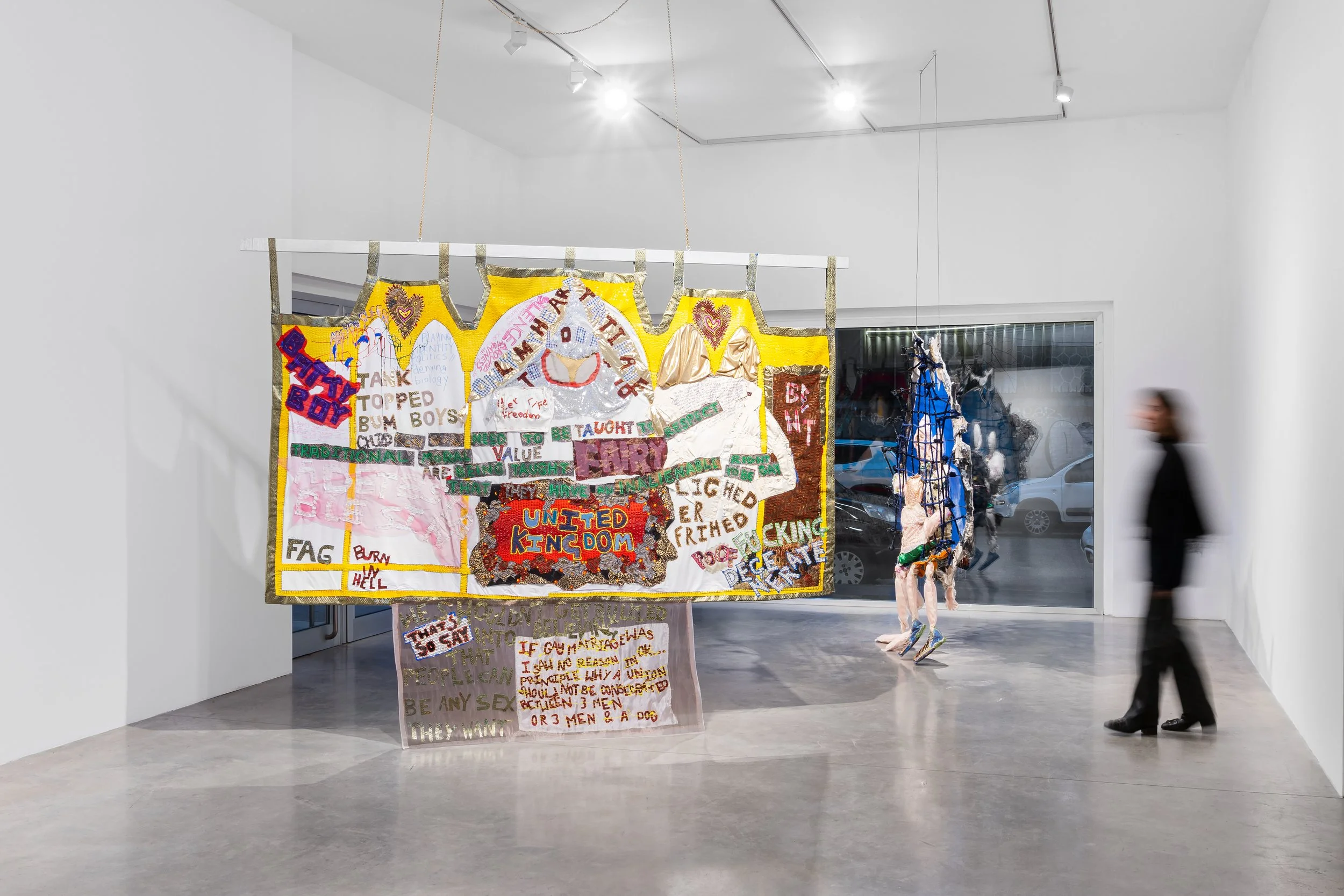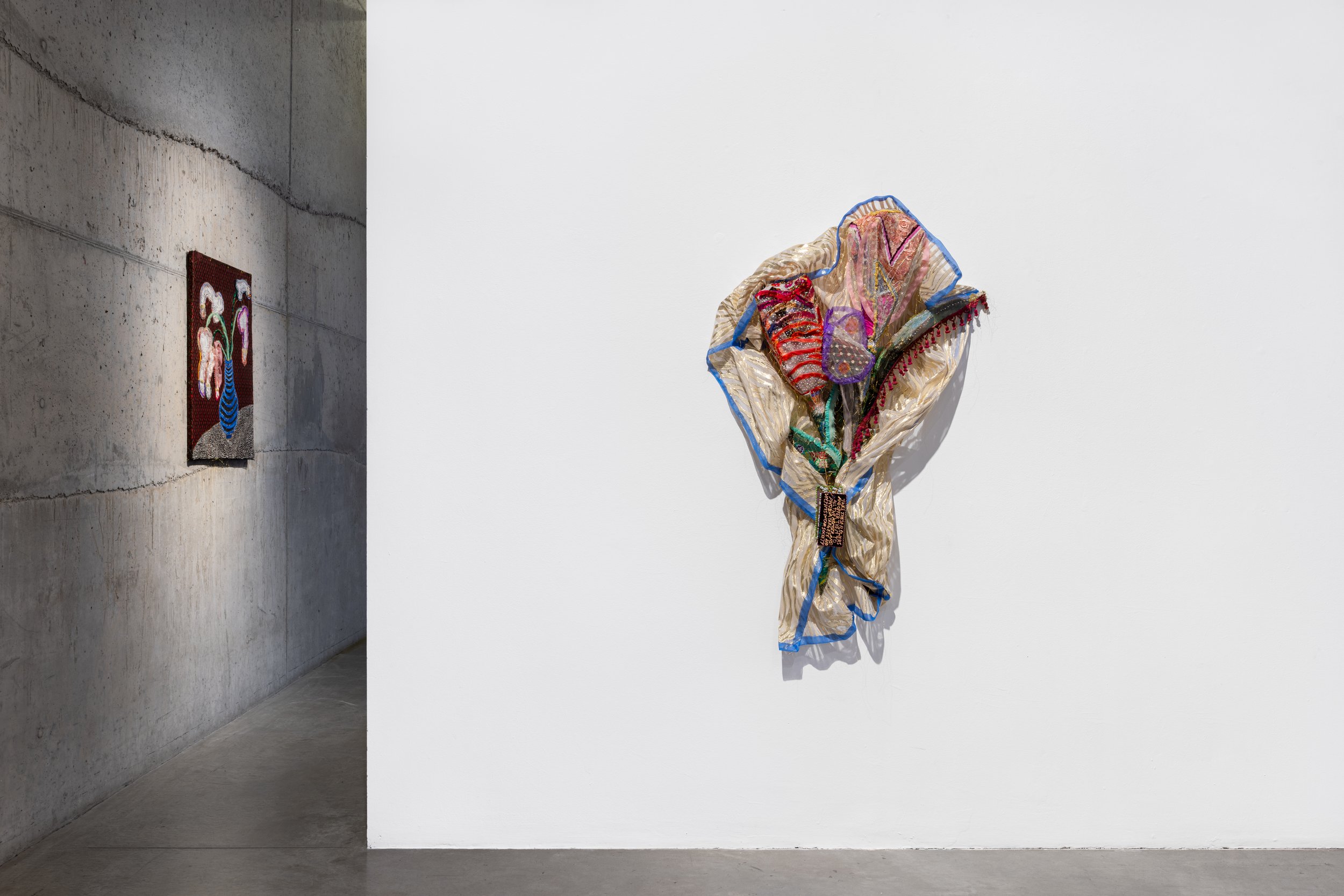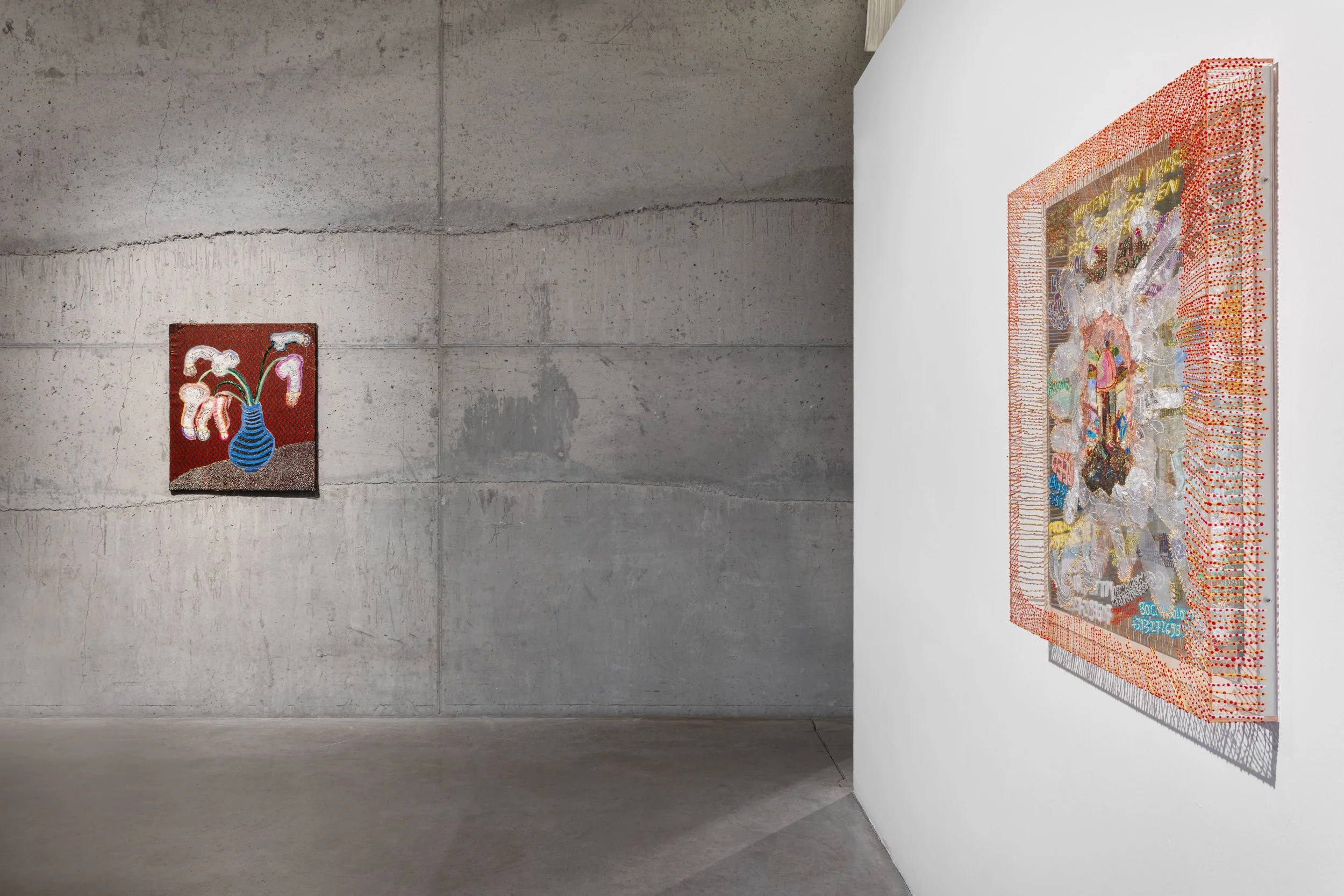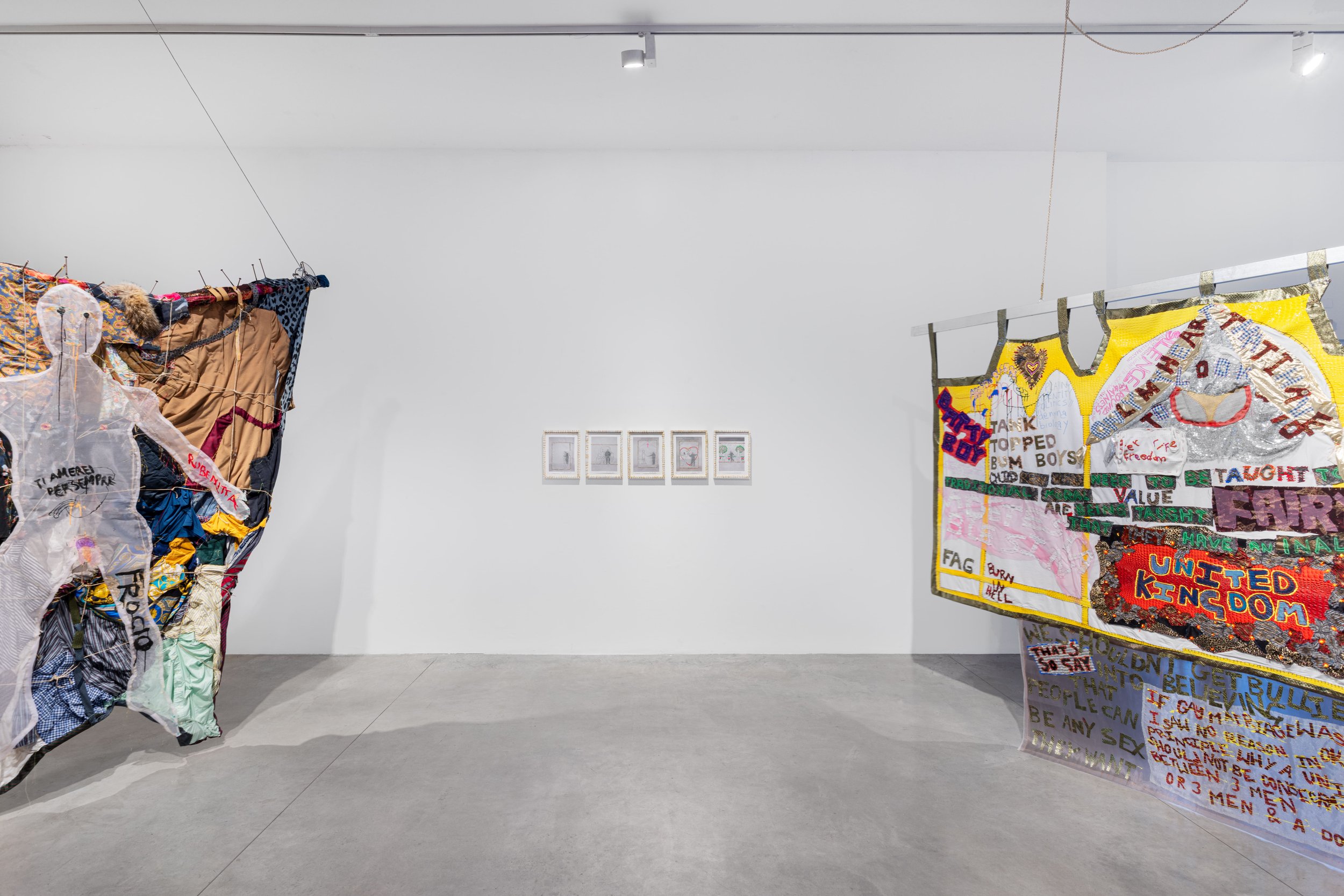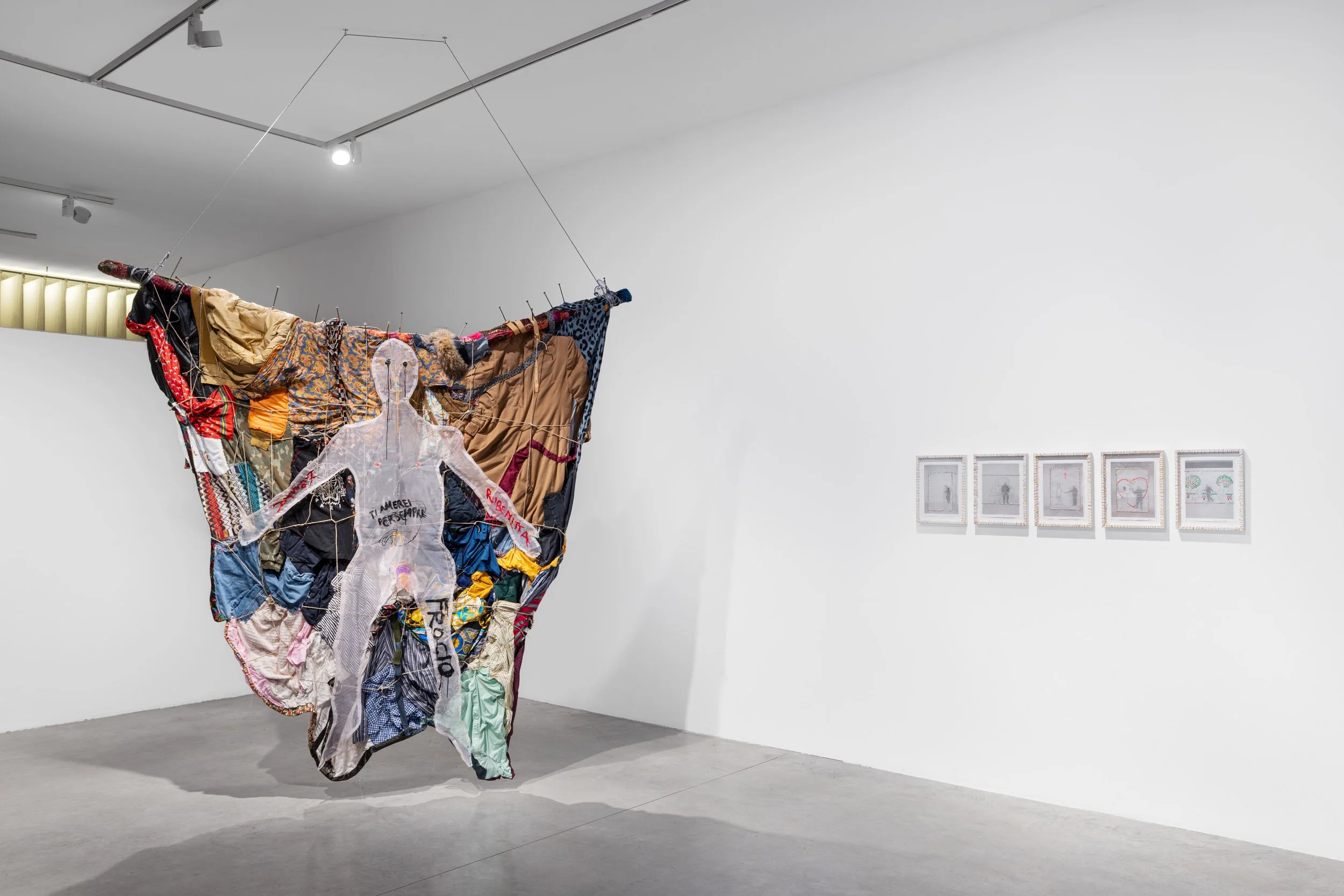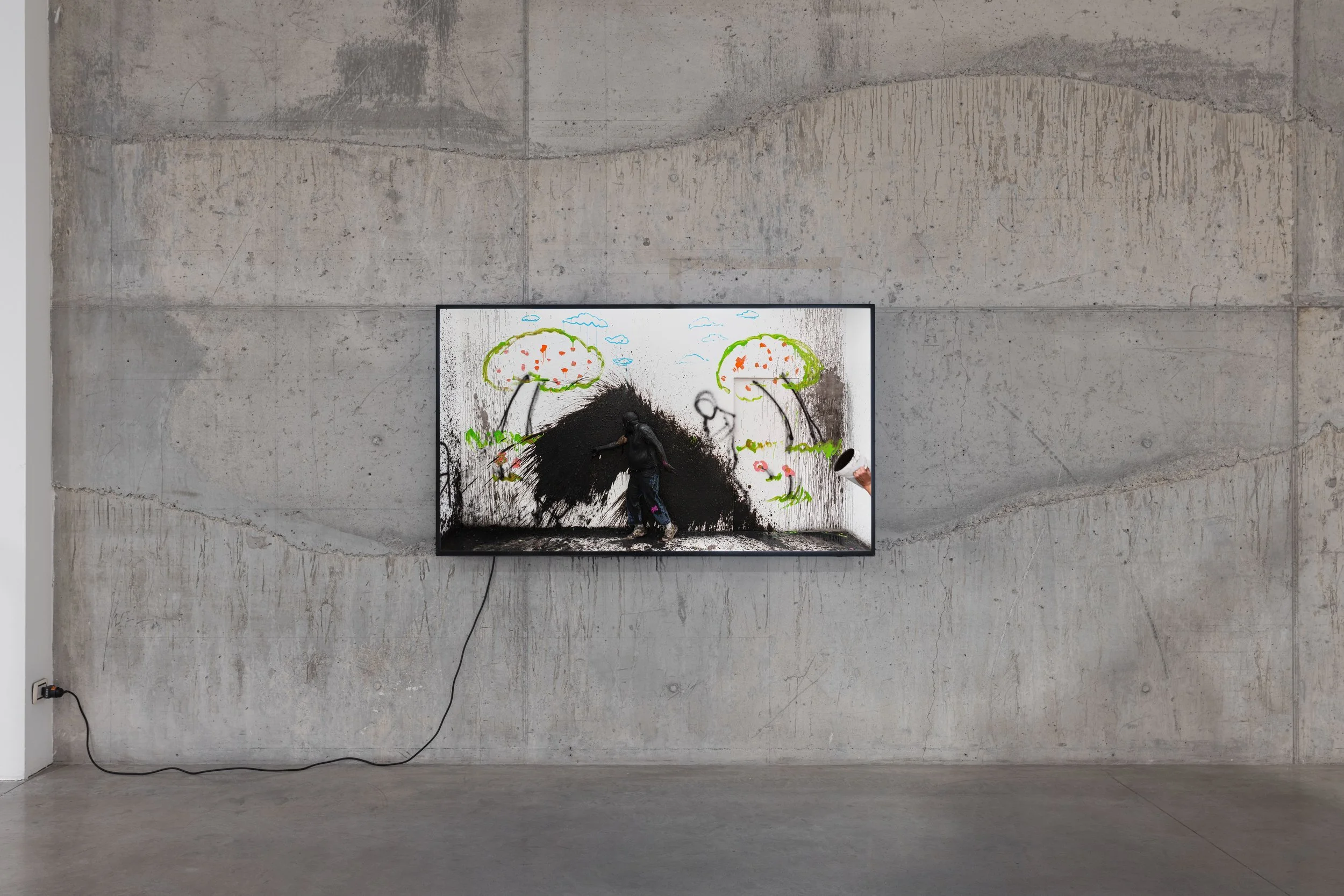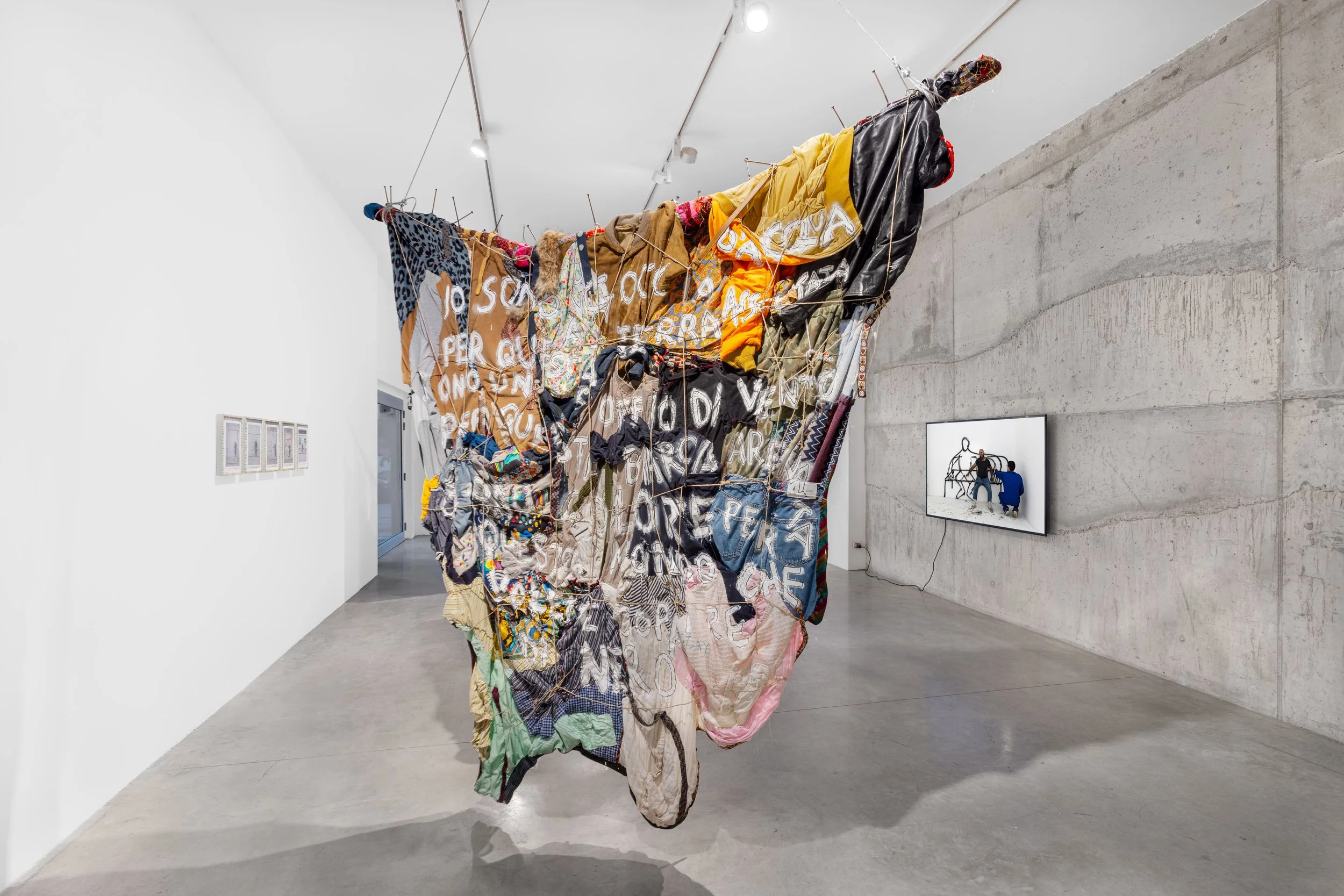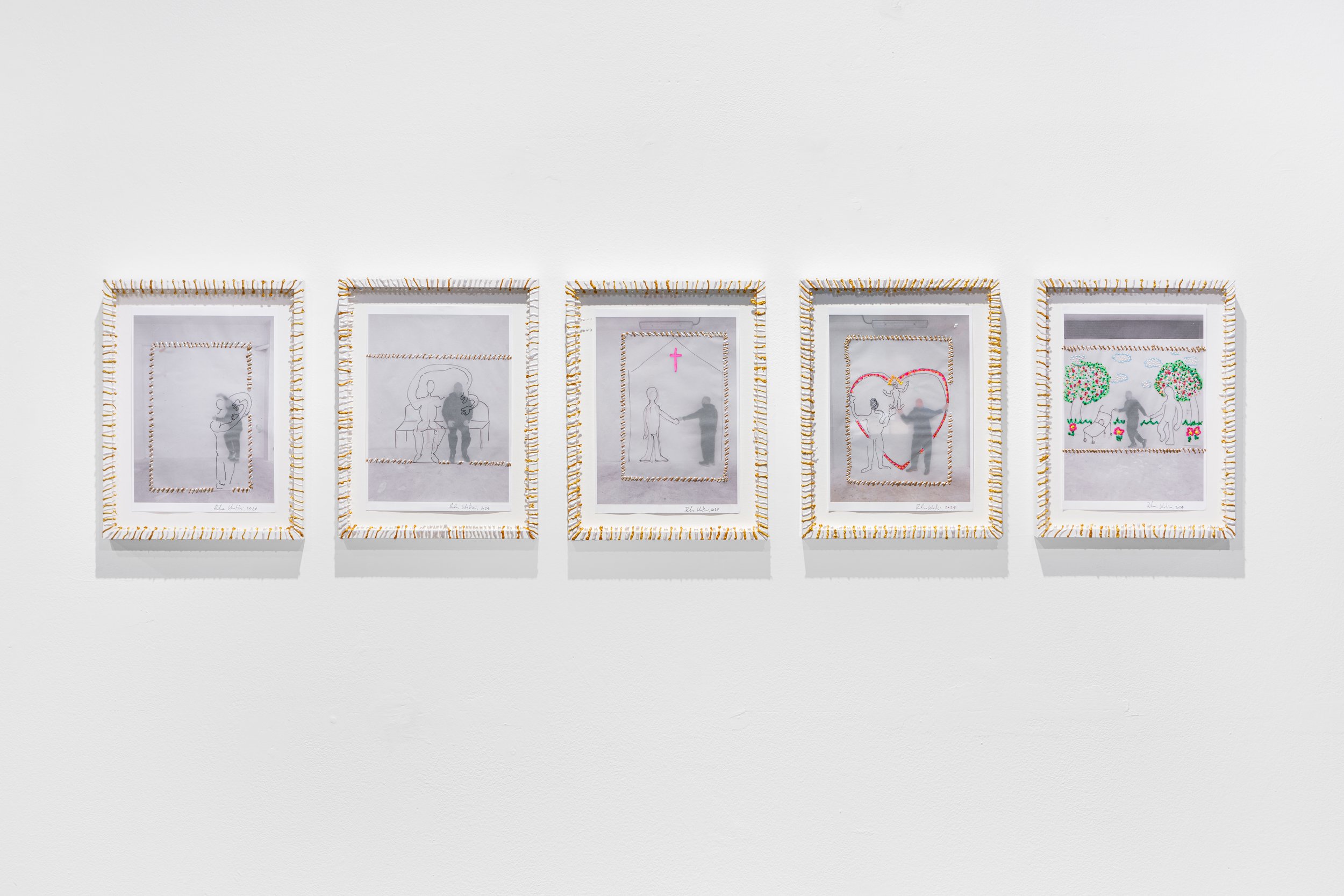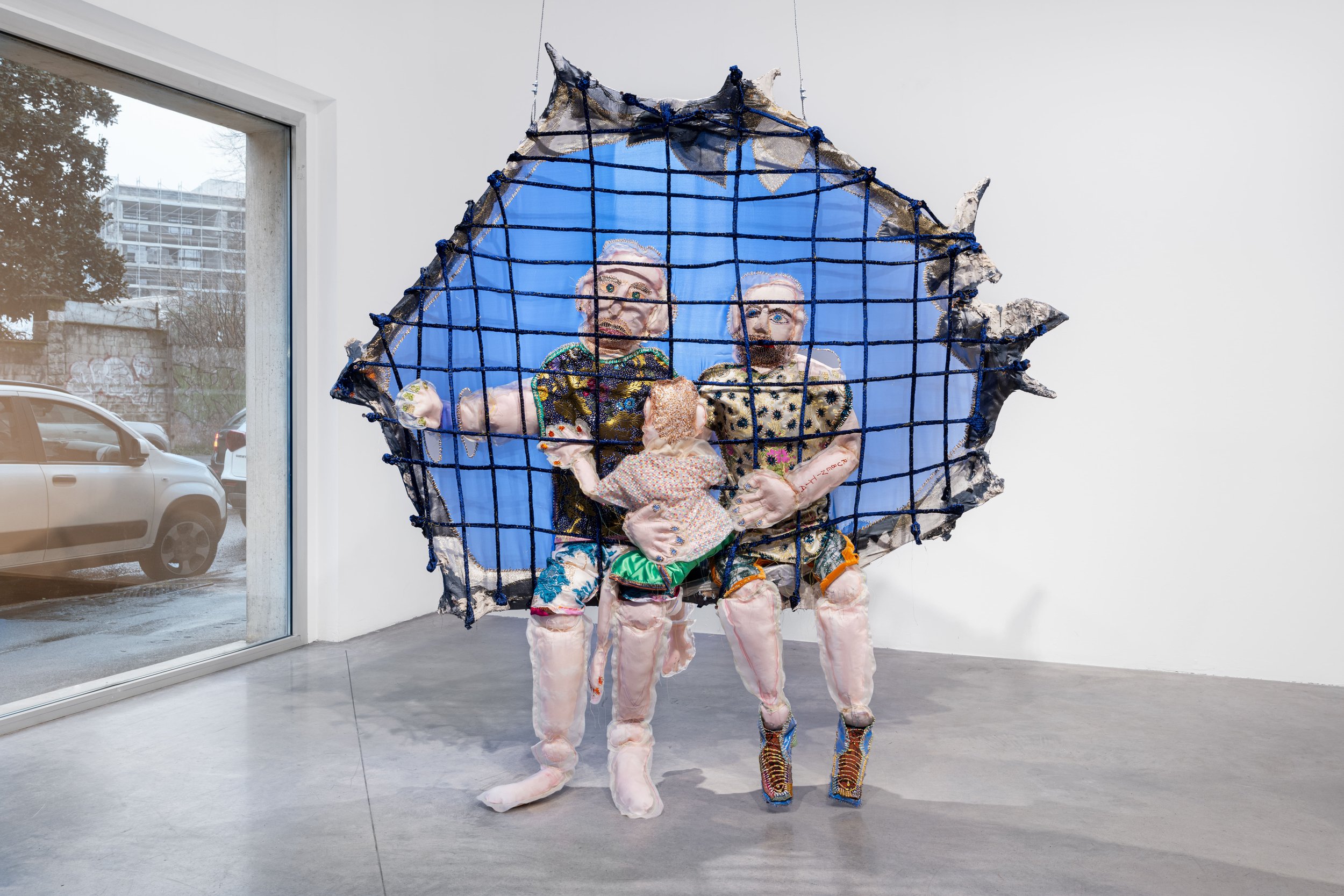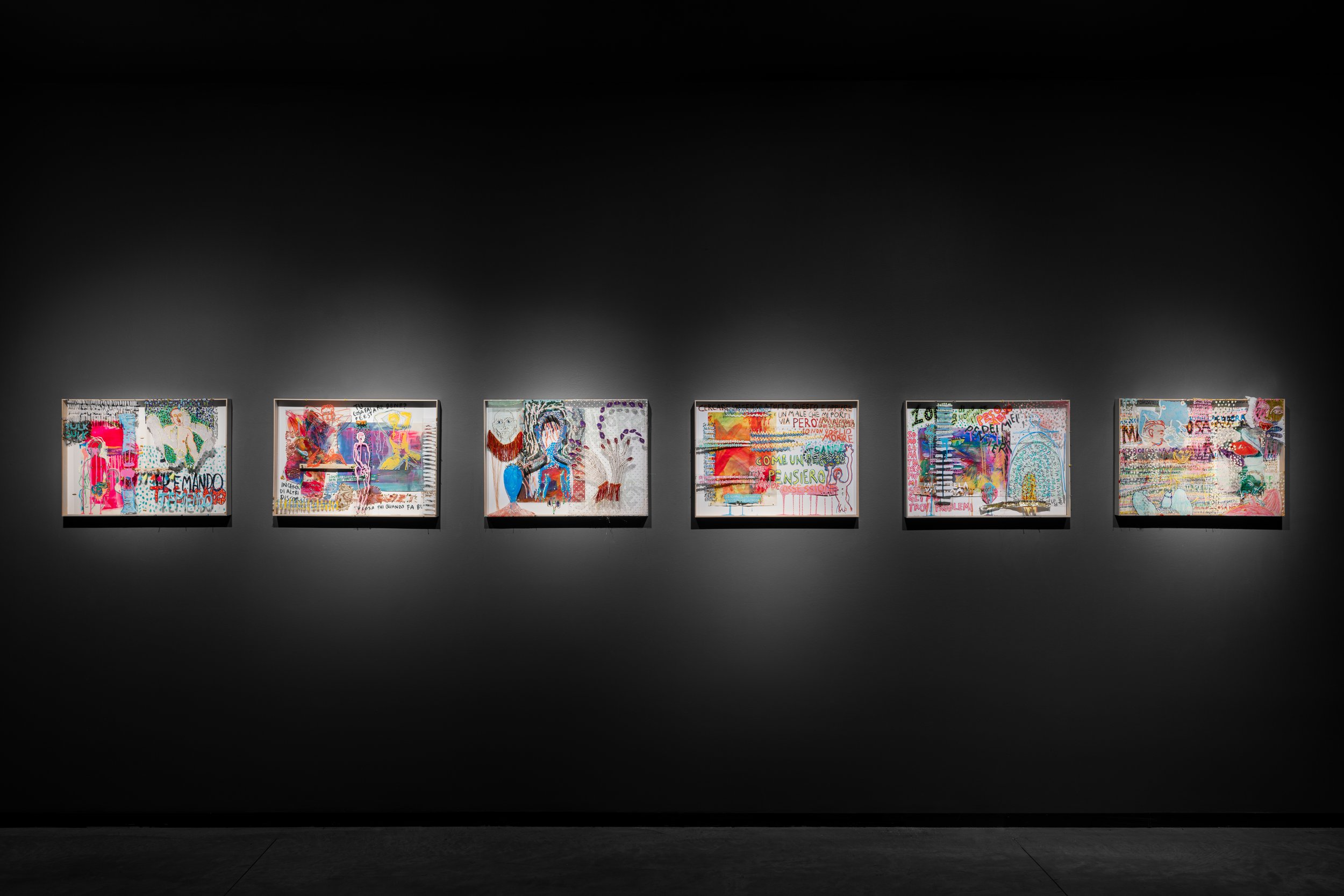Come fuoco in una pozzanghera come fuoco spento
Critical texts by Arnold Braho, Domenico De Chirico
PROMETEO GALLERY Ida Pisani, MIlan
22/01/2025 - 15/03/2025
Exhibition view at PROMETEO GALLERY Ida Pisani, MIlan. Ph Nicola Morittu
“Come fuoco in una pozzanghera come fuoco spento” (Like fire in a puddle, like fire out)
Critical essay by Domenico de Chirico
Markedly hesitant with respect to any form of ostracism, misoneism and underhandedness, appealing in direct line to what the French historian and philosopher Michel Foucault stated in his essay Sorvegliare e punire. Nascita della prigione, whose first Italian edition dates back to 1976, namely that ‘historically, the process by which the bourgeoisie became the politically dominant class in the course of the 18th century is disguised by the establishment of an explicit, codified and formally egalitarian legal framework, made possible by the organisation of a parliamentary representative regime. The general legal form that guaranteed a system of rights, egalitarian in principle, was underpinned by these tiny, everyday, physical mechanisms, by all these micro-power systems - essentially non-egalitarian and asymmetrical - that we call disciplines’, Ruben Montini, likewise examines the evolution and consequences of the practices of punishment, discipline and surveillance in the arduous context of Western societies and beyond, analysing more specifically how power is exercised, outside and inside the domestic environment, not only through physical coercion but also through strong psychological and social control.
Protean and visceral, his work, peremptorily placing itself in the midst of a prohibitive and spectacularising flow, takes shape in reciprocal and continuous contaminations between performance, sculpture, installation and video, under the banner of both first-hand experiences and others handed down by third parties, most inherent to the LGBTQIA+ world, including themes related to the queer community, gender fluidity and identity. Moreover, by oscillating between individual experience and the irrepressible desire for an equal and egalitarian collective existence, it tangibly strengthens the global dialogue on human rights and inclusiveness.
All these assumptions are not reduced to an inert repertoire of quotations, but vibrate ardently, making the chords of the quivering present bleed, copiously fuelled by the question of migrants, by the more current than ever global attempt to deconstruct the identity of the human being, by the resurgence of nationalisms, by cultural flattening, as well as by the thorny question of human rights, which, in his case, stands furiously against all forms of homotransfobia and, more generally, discrimination. Out of social tangles, the result of unhealthy ideological involutions, everything is here decanted in the respect of its colour and incomparability, here where the intersecting fabrics that delineate the burning perimeters of the discernible human figures that, elongated and potentially mobile, find, like flowers, their light in the intrigue scream out. And it is because of all this that Ruben Montini devotes a great deal of his attention to the human figure, first stripping it bare and then representing it in a language that may seem theatrical, sometimes sacrilegious sometimes lively. His interpretation of the body is not limited to naturalism, but moves towards a profound investigation of the emotions and the human psyche, dealing with themes such as pain, fear, self-flagellation, loneliness, physiological disorders and alterations, abuse, imbalance, penury, ecstasy, redemption, and finally, catharsis.
In fact, his figures often seem to be prisoners of themselves, but at the same time they emanate a kind of sacred and inestimable power. In doing so, he highlights the inevitability and uniqueness of existence and the intensity of the human experience, exploring the tension between light and darkness, life and death, beauty and suffering. Through a vivid polytheism of hand-sewn textiles, a powerful metaphor of both collaboration and collectivity and of memory and continuity, aimed at exploring human relationships, the construction of collective meaning and the interaction between individuality and extended community, as well as colours, materials, images, words, slogans of denunciation or awareness-raising, her art seeks to express the interconnectedness of opposites, suggesting that every aspect of human life is intrinsically linked to the other. His unmistakable style is highly analytical and visibly provocative. He uses an extensive historical, philosophical, sociological and empirical repertoire that forms the basis of his research as well as the texture of his works. His approach is systematic and interdisciplinary, mixing history, politics, philosophy and psychiatry, and he uses a specific vocabulary that very often hints at provocations that, at every turn, invite the onlooker to reflect on how power structures operate in everyday life, trying to show how these have evolved genealogically in response to new necessities.
Finally, exactly as the Romanian-born artist Dan Perjovschi, known for his works combining humour, social criticism and global politics, whose conceptual power often invites reflection, declared in one of his interviews: ‘I grew up in a society that did not have a variety of voices in public art. Everything was controlled and censored [...] The first graffiti I saw in 1989 was revolutionary, it said: ’Down with Dictatorship! I will never forget this graphic scream ‘*. Similarly, Ruben Montini, albeit in a different time and context, in the light of his more recent experiences, once again gives us, on the occasion of Come fuoco in una pozzanghera come fuoco spento, a title borrowed from one of the works in the exhibition, a proscenium in which it is possible to express oneself by calling things by their right and irreplaceable name.
Considering, then, that modern society does not merely punish but continually produces new ways of being, new forms of subjectivity that adapt to the demands of discipline and surveillance, the lingering doubt, however, is always the same: how can the uniqueness of the individual human being affirm itself without ever failing to listen in order to understand its position in the world and empathise with otherness? And more appropriately, as verbalised by Emil Cioran in At the Height of Despair, his first philosophical work published in 1934, namely: ‘what if the human face faithfully expressed all the suffering within, if the expression translated all the inner torment? Would we still be able to converse? Would we not have to talk by hiding our faces with our hands? Life would become decidedly impossible if our features revealed the intensity of our feelings. No one would have the courage to look in the mirror any more, because an image at once grotesque and tragic would mix the contours of physiognomy with bloodstains, ever-open sores and rivulets of unstoppable tears'. A primordial fire, precisely, discernible in the contortions and expressive variety of the works on show, the memory of which can be glimpsed manifested in the mute yet fierce glow, a multicoloured language that decants the flesh of reality in a world tuned to wearisome transience.
* Ten Questions to Dan Perjovschi - Interview by Marius Meli published on Kunstkritikk - 13.11.14 - https://kunstkritikk.com/ten-questions-dan-perjovschi/
Ruben Montini. Farsi carico farsi carico farsi carico
Critical essay by Arnold Braho
Taking on conflicts means first of all adhering to other levels of knowledge, and moving in the direction of what is common . Taking on conflicts can mean radically taking on diversity as a methodical condition of the subversive proposal, but also as a presupposition of the project of self-valorisation of identity . Taking charge of conflicts means in the exhibition Come fuoco in una pozzanghera come fuoco spento eradicating the idea of heterosexuality as a wall pre-constructed by nature, and reducing it to nothing more than a language: ‘a mass of signs, communication systems, coercive techniques, social orthopaedias and corporal styles’.
Ruben Montini dedicates his artistic practice and activity to placing the vulnerability of LGBTQAI+ bodies and their survival at the centre of political discourse, conceiving culture as a forum for the creation and interchange of ideas, and making his collective activity the place where the limits of the socially possible are defined: the centre of a primarily linguistic struggle. Within this framework, it is always his body that becomes the catalyst for violence and the sedimentation of ferocity. There is in fact in this approach the aim of producing, through performance and its installation works, a certain kind of consciousness and empowerment in the public, analysing a certain idea of ‘freedom’ that Mario Mieli already questioned in 1972 in his article Per la critica della questione omosessuale (1972), published in the magazine FUORI! (Fronte Unitario Omosessuale Rivoluzionario Italiano). The attempt is once again to activate a theorisation for a politics of homosexual liberation, aimed at verifying the perspectives already formulated and those yet to be constructed.
The freedom criticised by Mieli is a freedom that only guarantees exclusion and repression. It is a freedom that, although sanctioned by law, allows people to be marginalised, oppressed, mocked, subjected to moral and physical violence, and confined to a squalid and dangerous ghetto, as happens in Italy. A similar condition is also experienced by homosexuals in other capitalist countries - in fact, it is the Gay International News that points out how in those years, even outside Italy, the law is presented as a guarantor of a formal freedom, but in reality leaves the dynamics of oppression intact.
Thus queer identities, despite being ‘legally free’ in many advanced capitalist countries with democratic constitutions, remain in practice confined to a kind of inner circle, whose perimeter, although often not geographically well-defined, is nevertheless tangible. A perimeter, a regime, which Françoise d'Eaubonne has defined as phallocratic and heteronormative, criticising the ‘heteropatriarchal’ normalising institutions (the family, the school, the hospital, the prison) and the centrality of the apparatuses for constructing sexual identity within capitalism.
This taking on is presented in the exhibition project through different formulations, starting with the domestic one. It is no coincidence that the exhibition opens with Horny Dick at the loo (2024), a work conceived as a mirror, in the centre of which is an embroidered penis surrounded by various sexualising phrases, and which denies any other reflection, flanked by Vaso di Cazzi (2024), reproduced through the same technique, which characterises Ruben Montini's artistic practice. In the centre of the room is Altarpiece UK (2024), an installation presenting one of the many altarpieces Montini created together with groups of LGBTQAI+ people. The work was made with the participation of people of different nationalities, who were invited to use flaps of their clothing to sew homophobic insults onto as many pieces of cloth as the countries they come from, in all the languages of the world. ‘This altarpiece sacrifices a certain language, with the aim of formulating an ephemeral community without borders or laws, based on a common experience of abjection’.
How does one deal with a dominant language? With which body? With what weapons? Our relationship with the ‘totality’ of things, or presumed wholeness, is often coupled with the idea that these are characterised by continuity, constancy, the association of one thing in succession to another; on the contrary, the state of things present is also formed on the continuity of destruction. The walls of the asylum (2024), a performance realised by the artist with his collaborator Mattia Ozzy B., shows the inexorable attempt to fix the image of a homogenous family around the artist's body. An attempt that is continually repeated and erased by a third entity by means of a wave of black colour. Finally, Montini's little theatres, installed in the last room of the exhibition, are presented as conceptual maps in which it is the psychological condition that is the centre of the discourse, generated by the societies in which we are placed, proposing identification towards a series of normed roles, in which we should recognise ourselves and thus format our identities.
There was a time (the most rabid trail of which extends to the present day) when there was still no language outside the heterosexual narrative, but quoting the words of the philosopher Lorenzo Bernini verbatim again: ‘Out of space, out of time, yet here and now - like a revolution, like a miracle. Martyrs. Remains. Exactly, rubble. That's who, that's what: faggots of the world, unite!’.

